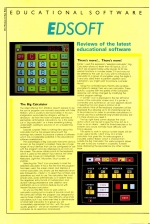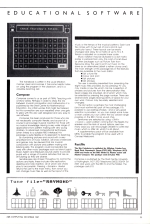
A&B Computing
 1st December 1987
1st December 1987
Categories: Review: Software
Author: Des Thomas
Publisher: 4Mation Educational Resources Ltd
Machine: BBC B/B+/Master 128
Published in A&B Computing 4.12
Reviews of the latest educational software
The Big Calculator
The latest offering from 4Mation doesn't appear to be the sort of program one normally associates with Mike Matson, who is usually to be found deep in his own imagination surrounded by dragons, witches or dinosaurs - far from the more mundane activities of elementary arithmetical calculations. So, is this really just a "big calculator" or is there something lurking underneath, waiting to pounce on an unsuspecting audience?
Surprise, surprise! There is nothing fishy about this calculator, but he has played around with the workings very cleverly to produce a piece of software which has considerable potential in the educational software marketplace.
The advantages of Big Calculator become obvious as soon as the program is loaded; there are a huge range of input devices that can be configured for use with the program and are displayed as six icons on the screen. The arrow initially points to the keyboard, which is used as the default input device, the other devices are mouse (or trackerball), Concept Keyboard, Light Pen, Microvitec Touch screen, or joysticks.
Selecting the "Start" icon proceeds to load the selected calculator. If this is the first time the program has been used, the screen clears and displays a normal calculator, you simply use the keyboard arrow keys followed by Return to select the numbers and operations you wish to use. The calculator, like most simple ones, works arithmetically, so it doesn't follow the algebraic entry format of multiplication and division taking precedence over addition and subtraction as is a common feature found with Hewlett Packard calculators.
So why put the BBC micro to work when a calculator costing just a couple of pounds could do the same job? Initially the program was designed for use by those children who have difficulty using small calculators, but if you have ever tried to demonstrate a hand-held calculator to a group you will immediately appreciate that this - with the usual quality graphics - will be an excellent use of the computer as an electronic blackboard. There's more?... There's more!
Earlier I used the expression "selected calculator", Big Calculator allows no fewer than 40 layouts, 32 of which are programmable while layouts 32-39 are special functions in number bases 2-9 and may not be altered by the user. So, if you wish to introduce a calculator to a group of youngsters using the digits 0-5 and only allow them to perform addition and subtraction, you might want to produce a simpler layout.
Using this controlled layout facility also enables youngsters to design their very own calculator. These options, coupled with the speed of the computer's response, can all be changed by modifying the control program settings.
A "printer" icon is displayed in the top left-hand corner of the calculator screen and, if a printer is connected and switched on, an icon appears above it. Selecting this icon gives a printout of all calculations. Most of the keyboard characters will be displayed thus allowing up to 24 characters per line to be printed out in order to annotate calculations. In normal use, this a somewhat long-winded process, but it is there should you need it.
The top right hand corner displays the clock option which can be set to give the time, act as a timer or as an alarm - useful for timed exercises or for children who would normally have difficulty with timing devices.
The ability to work in various number bases will be a very useful facility, I don't know of a simple calculator that gives this. An extra program is included called "Bases" which is chained from outside the Big Calculator. This useful program allows the user to key any number in a specific number base, displaying the equivalence any other number base.
The handbook is written in the usual 4Mation manner, clear and concise, it has some helpful notes on using the program in the classroom, and is a valuable teaching aid.
Compose
Compose comes to us as part of ITMAs 'Teaching with a Micro' series. Perhaps in order to stress the link between musical composition and mathematics it is published by the Shell Centre for Mathematical Education. Any initial worries that might be fostered by this connection are soon expelled when one gets to grips with this very well designed and very easy to use software.
Compose has been produced for those who are not necessarily computer literate, and as part of a course to encourage musical invention for those with no musical knowledge. Having a very wide range of applications from pattern making with very young children, to advanced compositional techniques (when linked to a suitable MIDI interface) this package is quite flexible in its approach to teaching.
By combining pictures and sound with a very simplified form of music notation, all kinds of exercises and games may be devised that link musical composition with picture and pattern making with listening skills. This program could conceivably be used with other music packages such as Island Logic's Music System and Medusa's Sounds Useful to provide pupils with a range of musical activities that are as stimulating as they are diverse.
Sensible keys are chosen throughout to control the options and tasks, these include note replication, deleting and note insertion; all of which are child's play to accomplish. Pressing Escape always returns the user to the main menu, from which you can change music files as well as the layout of the music or the tempo of the musical patterns. Each tune file comes with its own set of icons and its own particular layout. These layouts can be easily changed and allow for a matrix of up to 10 x 8. Tempo is adjusted on a simple linear scale.
Music notation may be dumped to a dot matrix printer in pictorial form only; this a bit of a let down as other packages such as Picture Train from Resource allow the user to print out music on the stave as an alternative (albeit a rather clumsy one!). The main strength of this package lies in the features that are available to the music Editor:
- Edit a tune file
- Colour and print
- Edit pictures
- Edit phrases
The user is sensibly prevented from amending the eight music files provided, but by pressing "N" you may create a new file which can be a selection of phrases and pictures from the demonstration files. Seven pages are provided, all of which which may be selected by pressing the page number. There are several blank pages leaving plenty of space for your own work. Colours may be easily selected and changed.
The last option is perhaps the most challenging (and most worthwhile!) part of the package: it is possible to use existing phrases - and a very good selection is provided - so you can adapt some tunes or even create your own within the two octave range possible on the BBC micros sound chip.
Semitones are selected by using Shift-Cursor; each pattern coming from the Beeb's tiny speaker and the lack of sound options, see how many ways you can encourage children to write real music, which is, after all, what it is all about.
A supplementary pack will be available from MESU to enable the program to be used with a Concept Keyboard.
Factfile
The Big Calculator is published by 4Mation, Linden Lea, Rock Park, Barnstaple, Devon EX32 9AQ. Telephone (0271) 45566 and works on the BBC Model B, Master series and Master Compact. The package costs £14 plus VAT.
Compose is published by The Shell Centre, University of Nottingham, NG7 2RD. Telephone (0602) 506101 Ext 2961 and works with the BBC B, and the Master. The package costs £13.
Other BBC B/B+/Master 128 Game Reviews By Des Thomas
This article was converted to a web page from the following pages of A&B Computing 4.12.








